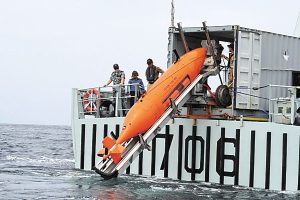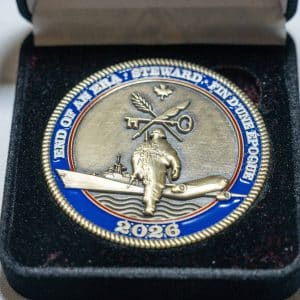
SLt Michael Van Vlaenderen and MS André Bienvenu, HMCS Yellowknife ~
When HMCS Yellowknife arrived in San Diego for Rim of the Pacific 2016 (RIMPAC), the ship’s crew welcomed four members of the Royal Norwegian Navy and embarked their Autonomous Underwater Vehicle (AUV), also known as the HUGIN.
Developed over the last 15 years by Kongsberg Maritime and the Norwegian Defence Research Establishment, the HUGIN 1000 conducts autonomous, semi-autonomous and supervised mine hunting operations and can operate in waters as deep as 3,000 metres.
Embarking the HUGIN and its equipment involved configuring Yellowknife, a Maritime Coastal Defence Vessel, in such a way that had never been done before, including fitting two additional containers to the back of the ship. This meant that any response from the ship’s company to commonly practiced emergency procedures, such as a man overboard or fire and flood control, had to be adjusted to fit the new layout.
“The ship’s engineering department carefully analyzed the impact the new payload would have on the ship’s stability, requiring them to make adjustments to the ship’s ballast,” said Chief Petty Officer Second Class Evan Mills, Chief Engineer. “Other considerations for the integration of the HUGIN system included running cabling and antennae to the bridge to ensure proper integration of HUGIN’s command and control systems.”
The HUGIN is launched off the stern of the ship, directly out of its container using a hydraulic launch and recovery system. Once in the water, the HUGIN begins travelling on its pre-programmed course. Within a few minutes, it dives below the surface, conducting a survey of the ocean floor with its high-resolution sonar, or identifying previously found objects with its onboard optical imaging system.
“While underwater, HUGIN finds its way using a state-of-the-art aided inertial navigation system, and relays its position to the ship using an underwater acoustic modem deployed from the ship,” said Lieutenant Commander Helge Telle, Norwegian Officer in charge of HUGIN. “During the course of its mission, which usually runs for four to six hours, HUGIN will surface several times at pre-programmed intervals to communicate with the ship via UHF radio, receiving an up-to-date position and updates to its mission plan.”
To recover the HUGIN, the ship manoeuvres close to the AUV, which detaches its nose cone, then sailors attach a line to the AUV and use it to position the vehicle onto the launch and recovery system. Once the HUGIN is safely onboard, the team can begin its post mission analysis to read the data collected during the mission.
After its first few deployments, it quickly became apparent just how effective the HUGIN system is at detecting and identifying objects on the sea floor. In the first week of the exercise, HUGIN had identified nine simulated mines.
“This year’s RIMPAC has proven to be an incredible learning experience in mine countermeasures for all members of HMCS Yellowknife and the Norwegian sailors onboard,” said Lieutenant Commander Donald Thompson-Greiff, Commanding Officer of HMCS Yellowknife. “The crew did an outstanding job with integrating the HUGIN system on this ship, and it is another example of how the Royal Canadian Navy works closely with our allies to ensure interoperability on any exercise or operation around the world.”
Twenty-six nations, more than 40 ships and submarines, and over 200 aircraft and 25,000 personnel are participating in RIMPAC from June 30 to Aug. 4, in and around the Hawaiian Islands and Southern California. The world’s largest international maritime exercise, RIMPAC provides a unique training opportunity that helps participants foster and sustain the cooperative relationships that are critical to ensuring the safety of sea lanes and security on the world’s oceans. RIMPAC 2016 is the 25th exercise in the series that began in 1971.








